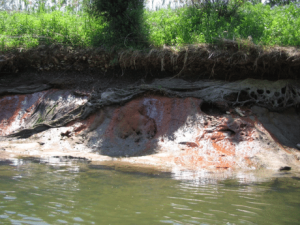On October 19th, the U.S. EPA’s new safeguards on the disposal of coal ash went into effect nationwide. The rules are targeted to prevent impoundment failures (like the massive Kingston, Tennessee spill in 2008), protect groundwater beneath coal ash disposal sites, and establish basic requirements for maintaining these massive waste storage pits.
From now on, any new coal ash landfill, impoundment, or lateral expansion, will need a composite liner, a leachate collection system, groundwater monitoring, separation from groundwater, and other requirements for inspection and maintenance.
For existing coal ash pits, power plant operators need to begin inspection and monitoring requirements to meet deadlines on a rolling timeline.
Beginning immediately, utilities must:
- Establish a publicly accessible Internet site to post studies and reports
- Create public plans for handling coal ash that becomes airborne as “fugitive dust”
- Demonstrate safety for projects attempting to use “beneficial use” loopholes (e.g., dumping large amounts of coal ash to “fill” ravines or level out land, claiming the practice is “beneficial,” not “disposal”)
- Meet requirements for safe location and strong construction for new coal ash pits
Unlike many regulations for waste disposal, the U.S. EPA’s coal ash rule is “self-implementing,” meaning that there will be no federal enforcement. Instead, citizens and states must bring citizen lawsuits in federal court to enforce the rule.
Bottom line: it’s on us.
Utilities in Illinois have started creating websites where this information can be monitored by citizens (which we have linked below if you would like to keep up to date with a local power plant’s compliance). Over the next two years, more stringent standards of the rule will come into effect – and utilities will need to meet tighter standards and protect groundwater.
These companies are also considering the impact of the new Effluent Limitation Guidelines – requiring that power plants use affordable and effective modern technology to reduce pollution, or to eliminate the pollution altogether. The Effluent Limitation Guidelines (ELG) require that power plants to shift to dry handling and disposal of their coal ash, ending the practice of dangerous unlined impoundments.
What’s Next?
Looking forward, we’ll be keeping up with compliance requirements – monitoring utilities’ actions for the U.S. EPA coal ash rule.
With both the Coal Ash rule and the Effluent Limitation Guidelines, however, legacy impoundments – the old, polluting pits storing tons of coal ash next to our rivers, lakes, and streams – are left largely unregulated. Illinois is home to 91 coal ash pits, many of which are located at now-shuttered power generating facilities.
These legacy pits need Illinois-specific rules to protect the surrounding communities and waterways. These rules are in motion, but at risk from industry attacks (i.e., power plant operators who could easily leave the damages for communities to pay).*
Join the effort by asking your local representatives and decision-makers to support safeguards for Illinois communities .
Local leaders can file letters and resolutions with the Illinois Pollution Control Board push the rules forward .
Stay up to date with information on coal ash in Illinois
Contact Tyler Rotche for more information
trotche@prairierivers.org 217.344.2371 x.206

Dynegy Inc.
Baldwin Energy Complex (Baldwin, IL)
Coffeen Power Station (Coffeen, IL)
Duck Creek Power Plant (Canton, IL)
E.D. Edwards Power Plant (Bartonville, IL)
Havana Power Station (Havana, IL)
Hennepin Power Station (Hennepin, IL)
Joppa Power Plant (Joppa, IL)
Kincaid Generation Station (Kincaid, IL)
Newton Power Station (Newton, IL)
Wood River Power Station (Alton, IL)
NRG Energy
Joliet 29 Generating Station (Joliet, IL)
Lincoln Stone Quarry (Joliet, IL)
Powerton Generating Station (Pekin, IL)
Waukegan Generating Station (Waukegan, IL)
Will County Generating Station (Romeoville, IL)
City Water, Light and Power
Dallman & Lakeside Power Station (Springfield, IL)
Prairie State Generating Company
Prairie State Energy Campus (Marissa, IL)
Southern Illinois Power Cooperative
Marion Generating Station (Marion, IL)
Exempt Units
Crawford Generating Station, Midwest Generation (Chicago, IL)
Grand Tower Power Station, Ameren (Grand Tower, IL)
Hutsonville Power Station, Ameren (Hutsonville, IL)
Meredosia Power Station, Ameren (Meredosia, IL)
Prairie Power Pearl Station, Prairie Power (Pearl, IL)
Venice Generating Station, Ameren (Venice, IL)
Vermilion Power Station, Dynegy (Oakwood, IL)
*Illinois Coal Ash Rules: These state-specific rules are now before the Illinois Pollution Control Board. While the Illinois EPA and power plant operators throughout the state pushed for an indefinite stay (or hold) on the rulemaking, the Illinois Pollution Control Board (in agreement with Prairie Rivers Network, partner organizations, and over 800 citizens) denied this motion. The IPCB has limited the stay to a 120 period to evaluate proposed rules. …stay tuned for updates around March 4th, 2016.







